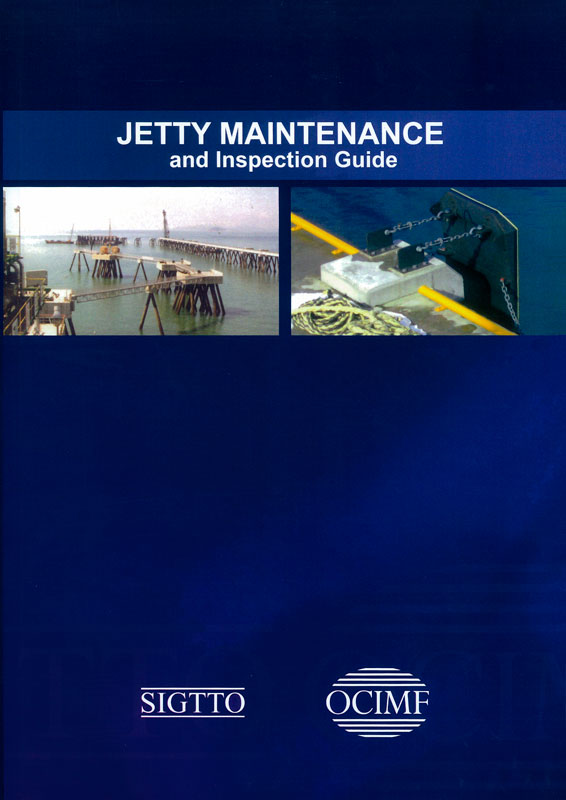Jetty Maintenance and inspection Guide
Мы не можем гарантировать его наличие и поступление на наш склад по указанной цене
Издание на английском языке.
Records show that the greatest risk of cargo escape is concentrated at the ship/shore manifold area. Therefore, equipment at the jetty head is of vital importance to the safe transfer of cargo between ship and shore. Because of the environmental conditions to which it is exposed, maintenance of equipment on the jetty is very important, particularly with regard to lubrication and corrosion protection. Maintenance is often made more difficult by access considerations and the need to interface with shipping operations. For these reasons, the Society of International Gas Tanker and Terminal Operators (SIGTTO) and the Oil Companies International Marine Forum (OCIMF) commissioned the writing of these guidelines.
Contents
Page
1 General maintenance principles
1.1 Introduction
1.2 Inspection and maintenance principles
1.2.1 Criticality assessment
1.2.1.1 Inspection Schedule
1.2.1.2 Maintenance Schedule
1.3 Summary
2 Topsides
2.1 Introduction
2.2 Transfer systems
2.2.1 Transfer ARMS
2.2.1.1 Basic Function
2.2.1.2 Failure
2.2.1.3 Inspection, Testing and Maintenance
2.2.2 Emergency release system
2.2.2.1 Basic Function
2.22.2 Typical ERS Operation
2.2.2.3 Failure
2.2.2.4 Inspection, Testing and Maintenance
2.2.3 Quick connect/disconnect coupler (QC/DC)
2.2.3.1 Basic Function
2.2.3.2 Failure
2.2.3.3 Inspection, Testing and Maintenance
2.2.4 Insulating flang
2.2.4.1 Basic Function
2.2.4.2 Failure
2.2.4.3 Inspection, Testing and Maintenance
2.2.5 Dock hoses
2.2.5.1 Basic Function
2.2.6 Breakaway couplings
2.2.6.1 Basic Function
2.2.6.2 Failure
2.2.6.3 Inspection, Testing and Maintenance
2.3 Mooring and berthing
2.3.1 Mooring equipment
2.3.1.1 Bollards
2.3.1.1.1 Basic Function
2.3.1.1.2 Failure
2.3.1.1.3 Inspection, Testing and Maintenance
2.3.1.2 Quick Release Hooks (QRH)
2.3.1.2.1 Basic Function
2.3.1.2.2 Failure
2.3.1.2.3 Inspection, Testing and Maintenance
2.3.1.3 Capstans
2.3.1.3.1 Basic Function
2.3.1.3.2 Failure
2.3.1.3.3 Inspection, Testing and Maintenance
2.3.1.4 Other Fittings
2.3.1.5 Load Cells
2.3.1.5.1 Basic Function
2.3.1.5.2 Failure
2.3.1.5.3 Inspection, Testing and Maintenance
2.3.2 Fendering
2.3.2.1 Basic Function
2.3.2.2 Types of Fender Systems
2.3.2.2.1 Elastomeric Systems
2.3.2.2.2 Flexible Dolphins
2.3.2.2.3 Other Systems
2.3.2.3 Failure
2.3.2.4 Inspection, Testing and Maintenance
2.3.3 Berthing AIDS-SPEED of approach indicator
2.3.3.1 Basic Function
2.3.3.2 Failure
2.3.3.3 Inspection, Testing and Maintenance
2.3.4 Radar
2.3.4.1 Basic Function
2.3.4.2 Failure
2.3.4.3 Inspection, Testing and Maintenance
2.4 Safety and environment
2.4.1 Ship-to-shore access
2.4.1.1 Basic Function
2.4.1.2 Failure
2.3.1.3 Inspection, Testing and Maintenance
2.4.2 Ship-to-shore links
2.4.2.1 Basic Function
2.4.2.2 Failure
2.3.2.3 Inspection, Testing and Maintenance
2.4.3 Lifting equipment
2.4.3.1 Basic Function
2.4.3.2 Failure
2.4.3.2.1 Cranes
2.4.3.2.2 Lifting Beams and Chain Blocks
2.4.3.2.3 Ancillary Equipment
2.4.3.3 Inspection, Testing and Maintenance
2.4.4 Fire-fighting and detection
2.4.4.1 Basic Function
2.4.4.2 Inspection, Testing and Maintenance
2.4.4.2.1 Test Intervals
2.4.4.2.2 Foam and Dry Powder
2.4.4.2.3 Passive Fire Protection
2.4.4.2.4 Fire Detection Equipment
2.4.4.2.5 Emergency Preparedness
2.4.5 Containment system
2.4.5.1 Basic Function
2.4.5.2 Failure
2.4.5.3 Inspection, Testing and Maintenance
2.4.6 Environmental monitoring equipment
2.4.6.1 Basic Function
2.4.6.2 Failure
2.4.6.3 Inspection, Testing and Maintenance
2.5 Common systems/utilities
2.5.1 Hydraulic systems
2.5.1.1 Basic Function
2.5.1.2 Failure
2.5.1.3 Inspection, Testing and Maintenance
2.5.2 Electrical equipment for hazardous areas
2.5.2.1 Basic Function
2.5.2.2 Failure
2.5.2.3 Inspection, Testing and Maintenance
2.5.2.3.1 Electrical Equipment in Hazardous Areas
2.5.2.3.2 Lighting
2.5.2.3.3 Earthing
2.5.3 Piping, valves, vessels and fittings
2.5.3.1 Introduction
2.5.3.2 Pipe Work
2.5.3.3 Pressure Vessels
2.5.3.4 Pressure Relief Valves
2.5.3.5 Valves
2.5.3.6 Strainers and Filters
2.5.3.7 Steam Traps
2.5.3.8 Stress Corrosion Cracking
2.6 Corrosion protection
2.6.1 General
2.6.2 Basic function
2.6.2.1 Coating
2.6.2.2 Cathodic Protection (CP)
2.6.2.2.1 Monitoring and Maintenance
2.6.3 Failure
2.6.3.1 Coating Breakdown
2.6.3.2 Degree of Corrosion Product
2.6.3.3 Blistering
2.6.3.4 Cracking, Flaking and Chalking
2.6.3.5 Stainless Steel Substrates
2.6.4 Inspection, testing and maintenance
2.6.4.1 Coating Repair Guide
2.6.4.1.1 Preventative Cleaning
2.6.4.1.2 Spot Repair
2.6.4.1.3 Renovation
2.6.4.1.4 Refurbishment
2.6.4.2 Inspection and Testing
3 Substructure
3.1 General
3.1.1 Berth types
3.1.2 Berth design
3.1.2.1 Piled
3.1.2.2 Caisson
3.1.2.3 Quay
3.2 Piling
3.2.1 Basic function
3.2.2 Failure
3.2.2.1 Background
3.2.2.2 Failure Mechanisms of Steel Piles
3.2.2.2.1 Corrosion
3.2.2.2.2 Overload
3.2.2.2.3 Sea Bed Interaction
3.2.2.2.4 Others
3.2.2.3 Failure Mechanisms of Concrete Piles
3.2.2.3.1 Overload
3.2.2.3.2 Corrosion
3.2.2.4 Failure Mechanisms of Timber Piles
3.2.2.4.1 Fungal Decay
3.2.2.4.2 Marine Organism Attack
3.2.2.4.3 Overload from Icing
3.2.2.5 Failure of Steel Sheet Piles
3.2.3 Inspection and testing
3.2.3.1 Frequency of Inspection
3.2.3.2 Above Water Preliminary Inspection
3.2.3.3 Underwater Preliminary Inspection
3.2.3.4 Above and Underwater Detailed Inspections
3.2.3.5 Areas for Inspection and Measurement
3.2.3.6 Steel Piles
3.2.3.7 Concrete Piles
3.2.3.8 Timber Piles
3.2.3.9 Steel Sheet Piles
3.2.4 Repair
3.2.4.1 Steel Piles
3.2.4.2 Concrete Piles
3.2.4.3 Timber Piles
3.2.4.4 Steel Sheet Piles
3.2.5 Maintenance
3.2.5.1 Steel Piles and Steel Sheet Piles
3.2.5.2 Timber Piles
3.3 Concrete
3.3.1 General
3.3.2 Failure mechanism
3.3.2.1 Chloride Attack
3.3.2.2 Cracking and Spalling
3.3.2.3 Sulphates
3.3.3 Inspection, testing and maintenance
3.3.3.1 Inspection Locations
3.3.3.2 Observations
3.3.4 Repair
3.3.5 Maintenance
3.4 Steel
3.4.1 General
3.4.2 Failure/deterioration
3.4.2.1 Corrosion
3.4.2.2 Abrasion
3.4.2.3 Structural Connection Failure
3.4.2.4 Fatigue
3.4.2.5 Overload
3.4.3 Inspection and testing
3.4.3.1 Frequency of Inspection
3.4.3.2 Preliminary Inspection
3.4.3.3 Detailed Inspection
3.4.3.4 Location - Where to Inspect and Measure
3.4.4 Repair
3.4.5 Maintenance
3.4.5.1 housekeeping
3.4.5.2 Anti-corrosion Coatings
List of abbreviations
Bibliography
Index




